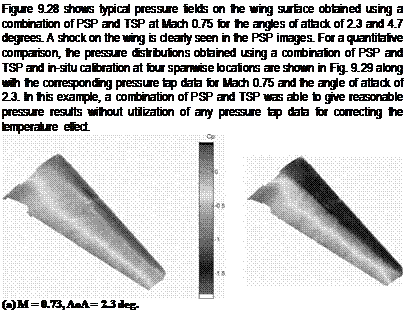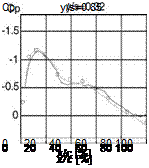. Transonic Wing-Body Model
Shimbo et al. (2000) conducted PSP measurements on an 8%-scaled model of the Mitsubishi MU-300 business jet at the Mach numbers 0.6-0.8 and the angles-of – attack 0-4.6 degrees in the 2-m transonic wind tunnel at the National Aerospace Laboratory (NAL) in Japan. The main objective of their tests was to examine the feasibility of PSP combined with TSP for correcting the temperature effect of PSP. The model was equipped with 32 pressure taps in four rows on the upper surface of the starboard wing. A water-cooled 14-bit CCD camera (1008×1018 pixels) attached with optical filters was used. A xenon lamp was used as an excitation light source and the light was introduced through optic fibers to light reflectors. Each light reflector had an optical filter such that only the UV light went through for paint excitation. The classical PSP, PtOEP in GP-197, was applied on the upper surface of the starboard wing for pressure measurements, whereas a typical TSP, EuTTA in PMMA, was applied on another wing for temperature measurements. Since the emission peaks of both PSP and TSP were close in the emission spectra, the luminescent intensity from both PSP and TSP were acquired on the same image using the CCD camera mounted on the ceiling of the test section. Assuming the flow symmetry with respect to the model centerline, Shimbo et al. (2000) used the temperature distributions on one of the wings obtained by TSP to correct the temperature effect of PSP on another wing.

Fig. 9.28. Typical pressure fields on the Mitsubishi MU-300 business jet model obtained using a combination of PSP and TSP at Mach 0.73 and a = 2.3 and 4.7 degrees. From Shimbo et al. (2000)
 |
 |
Fig. 9.29. Comparison between PSP (lines) and pressure tap data (circles) for the Mitsubishi MU-300 business jet model at Mach 0.73 and a = 2.3 deg. PSP data were obtained using a combination of PSP and TSP as well as in-situ calibration. From Shimbo et al. (2000)











